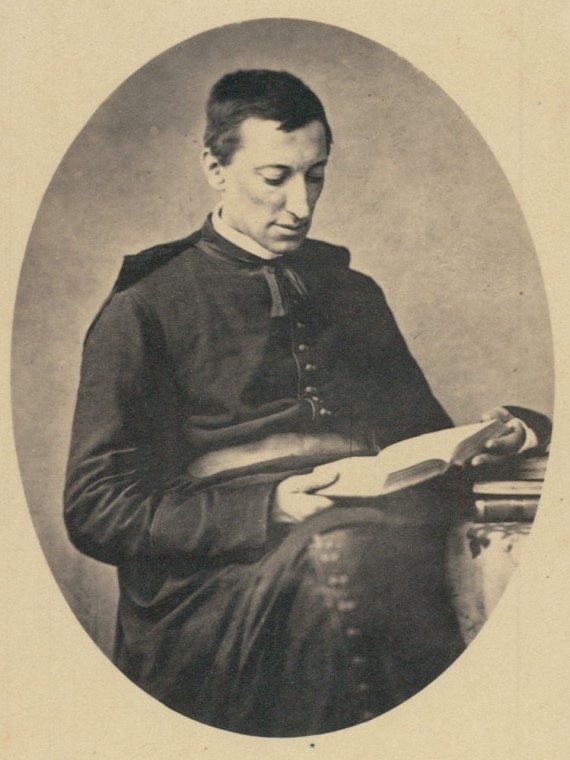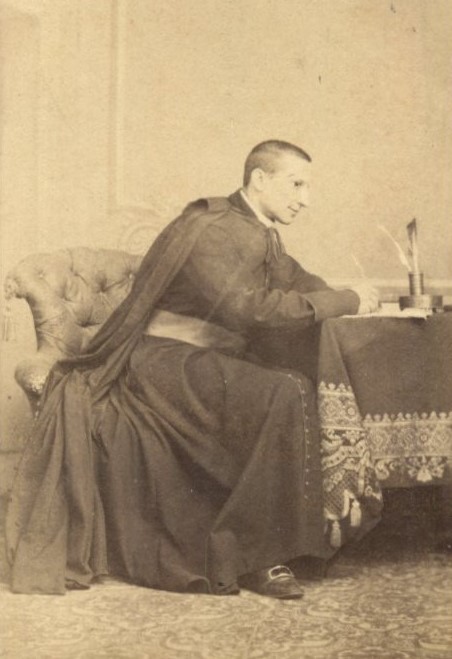Frédéric-François-Xavier Ghislain de Mérode
A Belgian prelate and statesman, born at Brussels, 1820; died at Rome, 1874. The son of Félix de Mérode-Westerloo who held successively the portfolios of foreign affairs, war, and finances under King Leopold, and of Rosalie de Grammont, he was allied to the best names of France, — Lafayette, Montmorency, Clemont-Tonnerre, etc.; the Mérode family claimed saints like Elizabeth of Hungary, founders like Werner who endowed the monastery of Schwartzenbroch, and a long line of captains from that Raymond-Bérenger who took the cross at St. Bernard’s call, to Frédéric, Xavier’s grandfather, who gave his life for the autonomy of Belgium. Bereft of his mother at the age of three, Xavier was brought up at Villersexel, in Franche-Comté, by his aunt Philippine de Grammont, attended for a time the Jesuit College of Namur, then entered the Collège de Juilly presided over by de Salinis, whence he passed (1839) to the Military Academy of Brussels. Graduating with the rank of second lieutenant, after a short service at the armoury of Liège, he joined (1844) as foreign attaché the staff of Maréchal Bugeaud in Algeria, taking a brilliant part in the most daring engagements and winning the cross of the Légion d’honneur. In 1847, he abruptly resigned the military career and went to study for the priesthood in Rome, where he was ordained (1849). Assigned, after his ordination, as chaplain to the French garrison of Viterbo, he was being pressed by his family to return to Belgium when Pius IX, with a view to attach him permanently to his court, made him cameriere segreto (1850), an office which entailed the direction of the Roman prisons. The excellent work done by de mérode for the material, moral, and religious betterment of the penitentiary system in Rome is described by Lefebvre (Des établissements charitables de Rome, p. 245.) and Maguire (Rome, Its Ruler and Institutions, p. 238); de Rayneval, the French envoy at Rome, praised it in an official report to his government (see “Daily News “, 18 March, 1848); Joachim Pecci, Archbishop of Perugia, wanted the young cameriere to inaugurate similar work in his metropolis, and the Piedmontese, despite their bias against everything papal, found nothing to change in the regulations introduced by de Mérode. In 1860, when it became evident that the insincere policy of Napoleon III was a poor safeguard against the greed of Piedmont, de Mérode, much against the views of the Roman Prelature, headed by Cardinal Antonelli, persuaded Pius IX to form a papal army and succeeded in enlisting the services of Lamoricière (q. v.) as commander-in-chief and was himself appointed minister of war. The task assumed by de Mérode and Lamoricière was difficult and well-nigh impossible; yet,the disasters of Castelfidardo and Ancona were due, not to the incompetence of the chiefs, nor solely to the heterogeneous nature of the recruits and the lack of proper supplies, but to the treachery of the Piedmontese who, while feigning to curb the Garibaldian bands, led them to the assault of the Papal States.
 The ensuing years of comparative quiet de Mérode spent in various public works; the building at his own expense of the campo pretoriano outside the Porta Pia, the clearing of the approaches of Santa Maria degli Angeli, the opening of streets in the new section of Rome, the sanitation of the old quarters by the Tiber, etc. His impetuous temperament and progressive views made him enemies among the old traditional Roman element just as the vehemence with which he branded the French Emperor’s duplicity turned against him the heads of the French army of occupation. Lamoricière’s death (19 Sept., 1865) became the signal of open hostility. Pius IX was forced to discharge his minister whose continuance in office, it was freely asserted, meant the withdrawal of the French troops. Reduced to a simple cameriere, de Mérode was not forgotten by Pius IX on Hohenlohe’s promotion to the cardinalate, he was given the vacant place of papal almoner and (22 June, 1866) consecrated titular Archbishop of Melitene. His new duties were to distribute the papal alms and to confirm children in danger of death and he acquitted himself with a liberality and zeal that won him the love of the poor and afflicted. At the Vatican Council, he showed the influence exercised over him by his brother-in-law, de Montalembert, and sided with the minority that deemed the definition of papal infallibility inopportune and even dangerous, but submitted the day the dogma was defined. After the capture of Rome by the Piedmontese (20 Sept., 1870) he followed his master into the retirement of the Vatican, leaving it only to fight the Piedmontese government’s pretensions on the campo pretoriano or to share de Rossi’s work in the excavations of Tor Marancino which resulted in the discovery of the Basilica of St. Petronilla. It is there he welcomed (14 June, 1874) the pilgrims from the United States and his last public utterances were for them. Speaking of his kinsman Lafayette, he regretted his defection from the purity of the Catholic Faith, but remarked that the country which the great general had so loyally served was yielding precious elements for the upbuilding of the Church; then, pointing to a Damasian inscription recently found, “Credite per Damasum possit quid gloria Christi”, he added with pathos that the edifying spectacle of American loyalty to Pius IX justified him in saying, “Credite per Pium possit quid gloria Christi”. He died of acute pneumonia in the arms of Pius IX, only a few months before the Consistory in which he was to have been made a cardinal. His remains were laid to rest in the Flemish Cemetery near the Vatican, amid a vast concourse of people, the poor he had so generously assisted mingling with the prelates, ambassadors, and princes. De Mérode, in spite of his faults, will be remembered as a model of unswerving loyalty to the Holy See. Such was his popularity that when Don Margotti, in “l’Unità Cattolica”, suggested in his behalf a world-wide tribute of prayers, the subscriber’s names filled a large album published at Turin, 1875.
The ensuing years of comparative quiet de Mérode spent in various public works; the building at his own expense of the campo pretoriano outside the Porta Pia, the clearing of the approaches of Santa Maria degli Angeli, the opening of streets in the new section of Rome, the sanitation of the old quarters by the Tiber, etc. His impetuous temperament and progressive views made him enemies among the old traditional Roman element just as the vehemence with which he branded the French Emperor’s duplicity turned against him the heads of the French army of occupation. Lamoricière’s death (19 Sept., 1865) became the signal of open hostility. Pius IX was forced to discharge his minister whose continuance in office, it was freely asserted, meant the withdrawal of the French troops. Reduced to a simple cameriere, de Mérode was not forgotten by Pius IX on Hohenlohe’s promotion to the cardinalate, he was given the vacant place of papal almoner and (22 June, 1866) consecrated titular Archbishop of Melitene. His new duties were to distribute the papal alms and to confirm children in danger of death and he acquitted himself with a liberality and zeal that won him the love of the poor and afflicted. At the Vatican Council, he showed the influence exercised over him by his brother-in-law, de Montalembert, and sided with the minority that deemed the definition of papal infallibility inopportune and even dangerous, but submitted the day the dogma was defined. After the capture of Rome by the Piedmontese (20 Sept., 1870) he followed his master into the retirement of the Vatican, leaving it only to fight the Piedmontese government’s pretensions on the campo pretoriano or to share de Rossi’s work in the excavations of Tor Marancino which resulted in the discovery of the Basilica of St. Petronilla. It is there he welcomed (14 June, 1874) the pilgrims from the United States and his last public utterances were for them. Speaking of his kinsman Lafayette, he regretted his defection from the purity of the Catholic Faith, but remarked that the country which the great general had so loyally served was yielding precious elements for the upbuilding of the Church; then, pointing to a Damasian inscription recently found, “Credite per Damasum possit quid gloria Christi”, he added with pathos that the edifying spectacle of American loyalty to Pius IX justified him in saying, “Credite per Pium possit quid gloria Christi”. He died of acute pneumonia in the arms of Pius IX, only a few months before the Consistory in which he was to have been made a cardinal. His remains were laid to rest in the Flemish Cemetery near the Vatican, amid a vast concourse of people, the poor he had so generously assisted mingling with the prelates, ambassadors, and princes. De Mérode, in spite of his faults, will be remembered as a model of unswerving loyalty to the Holy See. Such was his popularity that when Don Margotti, in “l’Unità Cattolica”, suggested in his behalf a world-wide tribute of prayers, the subscriber’s names filled a large album published at Turin, 1875.
LAMY, Monseigneur de Mérode (Louvain, 1874); BESSON, F. F. X. de Mérode, sa vie et ses œuvres (Paris, 1886); LE POITEVIN, Mgr. de Mérode in Les Contemporains (Paris, s. d.); VEUILLOT, Célébrités Catholigues Contemporains; FLORNOY, Lamoricière (Paris, 1904).
J. F. SOLLIER (Catholic Encyclopedia)










